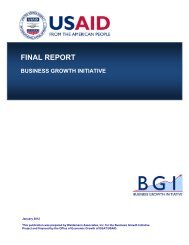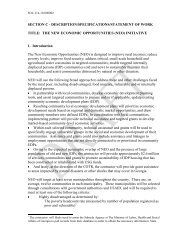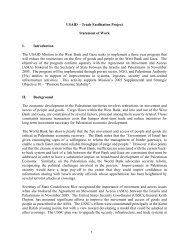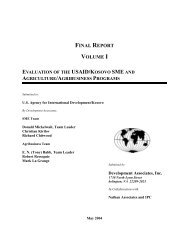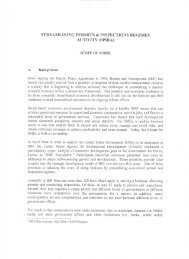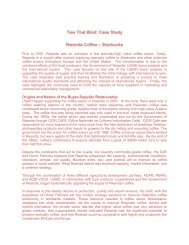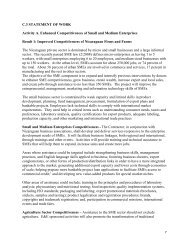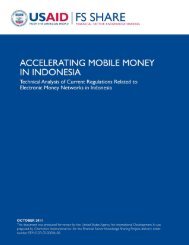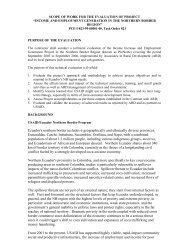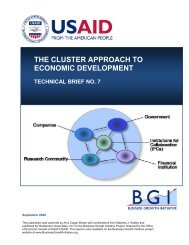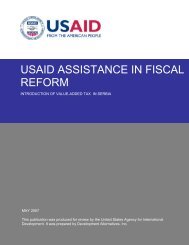Property Tax Reform in Developing and Transition Countries
Property Tax Reform in Developing and Transition Countries
Property Tax Reform in Developing and Transition Countries
Create successful ePaper yourself
Turn your PDF publications into a flip-book with our unique Google optimized e-Paper software.
esidential properties <strong>and</strong> 25 percent for non-residential properties. In addition, a 34 percent surtax was<br />
levied on the total property tax liability <strong>and</strong> earmarked for specific social services. If a taxpayer chooses<br />
not to self-assess,” the city will assess the value of property. For those who do comply, a 5 percent tax<br />
rebate is given.<br />
The new system also provides for a change <strong>in</strong> payment procedure. <strong>Tax</strong>payers may pay directly at a bank,<br />
<strong>in</strong> designated payment boxes, or at the electric utility. The net result of this process is that there is no<br />
longer any need for contact with the tax<strong>in</strong>g authority, <strong>and</strong> taxpayers have many more options for easy<br />
payment of their property tax bills.<br />
The first years of experience with the new property tax system showed some encourag<strong>in</strong>g results. The<br />
revenue <strong>in</strong>crease was due to several factors: an <strong>in</strong>crease <strong>in</strong> the collection rate from 64 to 79 percent, a 4<br />
percent <strong>in</strong>crease <strong>in</strong> the number of properties on the tax roll, <strong>and</strong> an <strong>in</strong>crease of about 28 percent <strong>in</strong> the<br />
amount of tax payment per property. Bangalore city officials estimate that one-third of the revenue<br />
<strong>in</strong>crease was due to revision <strong>in</strong> value, <strong>and</strong> that about three-fourths of all property owners paid higher<br />
property taxes.<br />
Another success of the reform was a reduction <strong>in</strong> compliance costs. The city offered its taxpayers a lower<br />
cost of compliance <strong>in</strong> return for a higher payment. Apparently, property tax <strong>in</strong>spectors regularly harassed<br />
taxpayers. It was reported that <strong>in</strong>spectors came on the property, sometimes unannounced, <strong>and</strong> oftentimes<br />
“negotiated” the property tax liability with the owners. Apparently, taxpayers were will<strong>in</strong>g to pay more<br />
under the new system to elim<strong>in</strong>ate this type of <strong>in</strong>formal contact with <strong>in</strong>spectors.<br />
Phase III: Revaluation under an area-based system<br />
The flaw <strong>in</strong> an area-based system is that it does not provide for automatic revenue growth unless there are<br />
discretionary changes <strong>in</strong> assessed value per square foot. The Bangalore model seems to have resolved this<br />
issue through a program of de facto revaluation.<br />
The tax officials have carried out a revaluation by assign<strong>in</strong>g many properties a different zonal<br />
classification, i.e., mov<strong>in</strong>g about one-half of all properties from a lower to a higher tax zone (Bruhat<br />
Bangalore Mahanagara Palike, 2008). The justification for do<strong>in</strong>g this is that the quality of public services<br />
has improved s<strong>in</strong>ce the orig<strong>in</strong>al zonal classifications were assigned. In this way, an automatic revaluation<br />
<strong>and</strong> a revenue <strong>in</strong>crease were built <strong>in</strong>to the system, help<strong>in</strong>g the government avoid an unpopular,<br />
discretionary <strong>in</strong>crease <strong>in</strong> the tax rate. The result was strik<strong>in</strong>g. Between fiscal years 1999-00 <strong>and</strong> 2000-01,<br />
property tax revenues <strong>in</strong>creased by 33 percent. Between 2007 <strong>and</strong> 2009, follow<strong>in</strong>g rezon<strong>in</strong>g of properties,<br />
property tax revenues doubled.<br />
In addition to the above measures, the city government has been mov<strong>in</strong>g to complete its fiscal cadastre.<br />
Among others, a GIS system has been <strong>in</strong>stituted, based on satellite photos <strong>and</strong> field-based tax mapp<strong>in</strong>g.<br />
This will have the effect of exp<strong>and</strong><strong>in</strong>g the tax base by add<strong>in</strong>g new properties.<br />
References<br />
Bruhat Bangalore Mahanagara Palike (2008). “<strong>Property</strong> <strong>Tax</strong> Self-Assessment Scheme H<strong>and</strong>book: 2008-<br />
2011” (Bangalore: Government Press).<br />
Rao, Vasanth (2008). “Is Area-based Assessment an Alternative, an Intermediate Step, or an Impediment<br />
to Value-Based <strong>Tax</strong>ation <strong>in</strong> India” <strong>in</strong> Mak<strong>in</strong>g the <strong>Property</strong> <strong>Tax</strong> Work, edited by Roy Bahl, Jorge<br />
34



